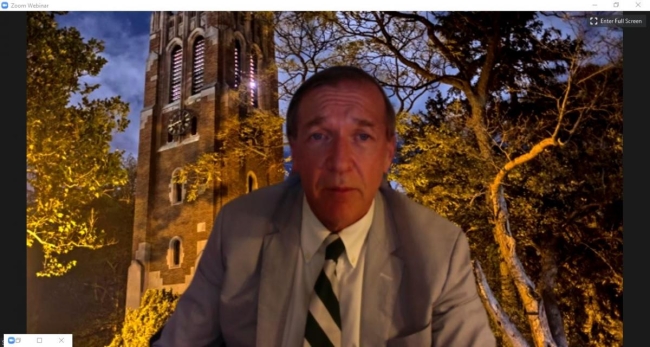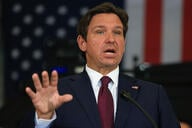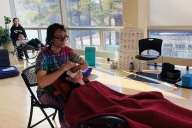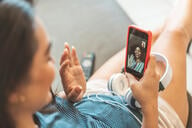You have /5 articles left.
Sign up for a free account or log in.

Michigan State University’s president, Dr. Samuel L. Stanley, took questions via videoconference.
Michigan State University/Screenshot
Michigan State University’s president, Dr. Samuel L. Stanley, listed events over the summer that gave university administrators cause for concern about reopening its East Lansing campus for in-person instruction this fall.
COVID-19 testing positivity rates generally rose across the country for the young adult demographic that includes college undergraduates. An East Lansing bar was tied to a June outbreak affecting well over 150 people. When Michigan State brought athletic teams back to campus, they initially recorded a low testing positivity rate, only to see additional cases among athletes and those working with them.
But the experience of other colleges and universities that had started classes earlier than Michigan State proved to be a decisive factor in a high-profile decision Stanley made Tuesday -- to call off in-person classes, ask undergraduates to stay home and hold fall instruction in remote and online formats.
“What we saw was both in schools that elected to test students before they came to campus and those who had not, two weeks in, many of them had started to see cases on campus -- and a significant number of cases on campus,” said Stanley, who took questions from reporters during a videoconference yesterday.
The Michigan State president is a biomedical researcher, and he sounded every bit the physician, delivering information at a rapid clip.
“This was very concerning to us,” he said of the rising cases on other campuses. “We took a look at their protocols. We actually communicated with some of those schools to understand what they were doing, and we came to the conclusion that while we thought our protocols were sound, many of them were not particularly different from the strategies that were employed by those other institutions. So we made the decision that was probably safest for our students, our faculty and staff.”
Michigan State’s decision to tell undergraduates to stay home came fewer than 10 days before campus move-in days and just over two weeks before the university was scheduled to begin fall classes with a mix of in-person and online instruction. The university is far from the only institution in the country to reverse plans to return to in-person instruction this summer. Hundreds of colleges across the country have been doing so.
But Michigan State nonetheless grabbed national headlines for its decision, which came on the same day that the University of Notre Dame suspended in-person classes and moved its undergraduates to remote instruction for two weeks in a bid to stave off sending students home because of a spike in coronavirus infections. It came the day after the University of North Carolina at Chapel Hill told undergraduates to go home as clusters of cases proliferated.
Institutions across the country are still planning to hold undergraduate move-in days in the coming weeks. So the experience of one president at a major research university who took a look at his peers and pulled the plug will be closely watched.
“I think time will tell whether it was the right decision or not, but I felt with the data laid out in front of us, looking at that data, where we saw these cases taking place, we saw what happened, where the number of beds that had been set aside for quarantine or isolation were exhausted very quickly -- that was a situation we didn’t want to be in,” Stanley said. “We were fortunate to have that data to help guide us in the decision. That made a big difference to us.”
Asked whether Tuesday’s decision could hurt enrollment or lead students to drop out, Stanley said he doesn’t know. He understands why students might think that way, he said. But he stressed that Michigan State faculty members will still be teaching courses.
Financial and staffing ramifications are possible, Stanley acknowledged.
“We’re still talking to our employees about this, and we’ll see how many people end up on campus,” he said. He acknowledged, though, that furloughs may take place.
Michigan State already furloughed many employees this summer. The university has a furlough policy in place through the end of the year that allows affected individuals to retain health benefits.
Some students will still be able to study and live on Michigan State's campus, such as graduate students, those in certain colleges or those who can’t continue their studies remotely. Research will also continue.
Some higher education leaders have argued students are actually safer on campus than they would be at home, or that they’re less likely to engage in risky behavior if they’re in the controlled environment of a university. Could closing a campus like Michigan State’s lead to risky behavior in its hometown of East Lansing as students living off campus cut loose after being untethered from in-person classes?
Michigan State is attempting to work with fraternities, sororities and officials in East Lansing so that those living off campus don’t create risky health situations. The university has already urged those living off campus to stay home instead of coming to town, if possible.
“The campus compact that we released still holds,” Stanley said. “We’re still saying to people, not only are you responsible for following these rules on campus, but we’re holding you responsible for following the rules off campus, as well. So if your municipality has a mask ordinance, we expect you to obey that, to comply with that.”
Michigan State athletes will be able to stay on campus for workouts. The Big Ten, in which Michigan State teams compete, last week postponed fall athletics for the rest of the year.
Stanley pointed out that Michigan State had told athletes that they could be present for workouts or practices long before the campus brought back undergraduates.
“We felt that, again, with the same careful monitoring we’re doing for any students on campus, we can do that,” he said.
Stanley was also asked whether he is ruling out the possibility of bringing undergraduate students back for in-person classes before the end of the fall semester. His answer was simple.
“Yes.”




